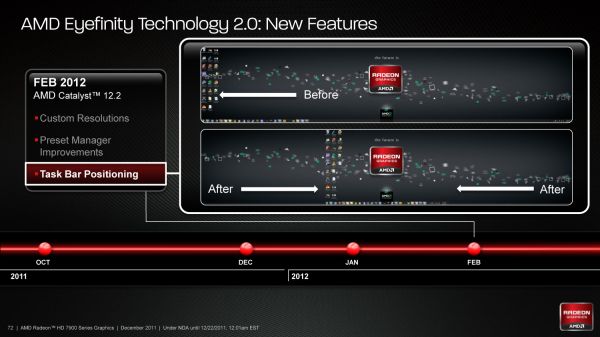AMD Radeon HD 7970 Review: 28nm And Graphics Core Next, Together As One
by Ryan Smith on December 22, 2011 12:00 AM EST- Posted in
- GPUs
- AMD
- Radeon
- ATI
- Radeon HD 7000
Display Tech: HD3D Eyefinity, MST Hubs, & DDM Audio
With the launch of the HD 5000 series back in 2009 AMD managed to get the drop on everyone, press and NVIDIA alike. Eyefinity, AMD’s Single Large Surface technology, came out of virtually nowhere thanks to a carefully orchestrated development plan that ensured very few people even within AMD knew about it. As a result of everything that was leaked ahead of time Eyefinity was not, making it AMD’s big eye catcher for the 5000 series.
As what was to be the first piece of the much dreamed about holodeck, AMD has been steadily working on it since 2009 in order to improve the experience even within their existing hardware by adding support for such features as bezel compensation and combining CrossFire with Eyefinity. For AMD it’s a feature of great importance even if end user adoption is still limited.
For the Southern Islands family AMD isn’t going to be pulling quite the rabbit out of their hat this time when it comes to displays. Southern Islands’ new display feature will be Discrete Digital Multi-Point Audio (which we’ll get to in a moment), but this doesn’t mean that AMD hasn’t continued to work on Eyefinity. Since October AMD has been engaged in an initiative they’re calling “Eyefinity Technology 2.0”, which is going to be pushed as a big part of the Southern Islands launch even though these are software improvements that will benefit all cards.
So what is Eyefinity Technology 2.0 composed of? We’ve already seen several new features starting with Catalyst 11.10, such as 5x1 portrait and landscape support and flexible bezel compensation support. The next step is going to be integrating Stereo 3D (or as AMD likes to call it, HD3D) into the mix, similar to how NVIDIA has 3D Vision Surround. Catalyst 11.12 introduced the ability to use HD3D with an Eyefinity display setup, and Catalyst 12.1 (preview out now) added support to do that in a CrossFire configuration. The final step is going to be with Catalyst 12.2 in February, which will add support for custom resolutions and the ability to relocate the Windows task bar to an arbitrary screen, two features that users have been asking about for quite some time. Again, all of these improvements are driver side, but they are a major component of AMD’s marketing for Southern Islands.
Speaking about Eyefinity, one issue that comes up time and time again is Multi Stream Transport (MST) hubs. We were introduced to MST hubs back with the launch of the 6800 series, which allowed a single DP 1.2 port to drive up to 4 monitors by taking advantage of the high bandwidth of DP1.2 and embedding transport streams for several monitors into the signal. The purpose of MST hubs was so that users could use several monitors with a regular Radeon card, rather than needing an exotic all-DisplayPort “Eyefinity edition” card as they need now.
But as many of you have asked me about, several deadlines for MST hubs have come and gone, including the latest deadline which was supposed to be by the end of this year. As with active DP adaptors this is largely out of AMD’s hands since they don’t produce the hardware, but they have been continuing to prod their partners on the issue. The latest deadline from AMD isn’t rosy – summer of 2012 – but they seem more confident of this deadline than deadlines in the past. Not that another half-year wait will be of any comfort for users who have been looking for MST hubs for the better part of the year, but at least it provides some idea on when to expect them.
Last, but certainly not least on the display technologies front is AMD’s new feature for Southern Islands, Discrete Digital Multi-Point Audio (DDMA). It’s a mouthful of a name but the concept is rather simple: it’s the next step in audio output from a video card. Video cards have been able to output audio for a few years now via HDMI, and more recently DisplayPort gained the ability. However GPUs have been limited to streaming audio to a single device, be it a monitor, TV, or receiver. With DDMA GPUs can send audio to multiple devices, and AMD is looking at how to put that ability to work.
The most basic use for being able to send audio to multiple devices is to individually address the speakers of each device, which is the cornerstone of AMD’s proposed use cases. Fundamentally AMD is looking at applications that involve matching audio streams to the monitor the relevant application is on – move a video player from your center monitor to your left monitor, and the audio from that video player should also move from the speakers on the middle monitor to the speakers on the left monitor. What can you do with speakers that are mapped to monitors? That’s what AMD wants to find out.
Being realistic for a moment, the 7970 isn’t going to be the card that sells this feature, as it’s a $550 gamer video card. Gamers are using dedicated 2.1/5.1/7.1 audio systems or headphones for surround sound, and while AMD does have a proposed multi-tasking use case for this it’s not very convincing. DDMA will become much more important on future lower end cards as those are the cards that go into family desktops, workstations, and the like. Thus the killer app for this feature (and certainly AMD’s best prepared scenario) is for video conferencing where each attendee is mapped to a monitor, and with DDMA a set of speakers on that monitor. AMD’s partner Oovoo is working on just such a system though it’s still early in development.












292 Comments
View All Comments
Scali - Monday, December 26, 2011 - link
Lol, how's that, when I'm the one saying that AMD's cards are the best performers in Crysis 2?I'm neutral, a concept that is obviously alien to you. Idiots...
Scali - Monday, December 26, 2011 - link
Heck, I'm also the guy who made Endless City run on non-nVidia cards. How does that make me an nVidia fanboy?CeriseCogburn - Thursday, March 8, 2012 - link
That's sad when an nvidia fanboy has to help all the amd fannies with software coding so they can run a benchmark, then after all that work to help the underprivileged, nothing but attacks after the facts... finally silence them.It's really sad when the truth is so far from the pop culture mind that actually speaking it is nearly forbidden.
Thank you for helping them with the benchmark. Continue to be kind in such ways to the sour whining and disgruntled, as it only helped prove how pathetic amd dx11 was...
james007 - Friday, December 30, 2011 - link
This sounded like such an awesome card and I was psyched to get it the moment it comes out -- until reading the part about dropping the 2nd DVI port. A DisplayPort-to-SLDVI doesn't do it, for me, because my desktop has to drive two 30" displays. In fact, I would love to be able to drive a third display so I can have a touch-screen also. My current (previous-generation) VDC does drive both displays just fine.This does not seem like such an infrequent requirement, especially for high-end users. Why would they drop the ability to drive the 2nd display? !!!
Argh!
The_Countess666 - Saturday, December 31, 2011 - link
not trying to sell you anything but, HDMI to dual-link dvi does exist (see link, or google yourself for other shops).http://sewelldirect.com/hdmi-to-dvi-dual-link-cabl...
and these cards do have 1 HDMI-out so that should work for you.
Penti - Wednesday, January 4, 2012 - link
It's the IHV that makes those decisions any way, just because it's not on a reference card doesn't mean they won't show up or that you can't build a card with it. But the HDMI supports more then 1920x1200 finally on this card any how. I guess they could deliver a card with the old type of DVI>HDMI adapters. Obviously opting for HDMI and multidisplaycapable displayport 1.2 makes more sense though. It's been around for years now.Penti - Wednesday, January 4, 2012 - link
Just make sure you actually has the number of connections you need when buying the card, many 7970 bords only appear to support single-link DVI on the DVI-connector.poordirtfarmer2 - Wednesday, January 4, 2012 - link
Enjoyed the article.So this new 79XX architecture is about a GPU architecture that’s also good for “compute work”. The reference to NVIDIA ‘s professional video cards (Quadro ; Telsa), implies to me that this might mean video cards viable for use both in gaming and in engineering / video work stations.
I’m not a pro, but do a lot of video editing, rendering and encoding. I’ve avoided dedicating a machine with an expensive special purpose QUADRO video card. Am I reading the wrong thing into this review, or might the new 79XX and the right driver give folks like me the best of both worlds?
radojko - Thursday, January 5, 2012 - link
UVD 3 in NextGen is a disappointing. Nvidia is two generation in front with PureVideo HD 5.psiboy - Monday, January 9, 2012 - link
Well Mr Ryan Smith I must ask why the omission of 1920 x 1080 in al lbenchmarks... given that almost every new monitor for quite some time has been natively 1920 x 1080... what is it with you guys and Tom's lately.. you both seem to have been ignoring the reality of what most of your readers are using!